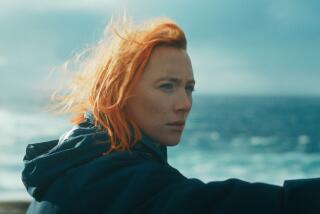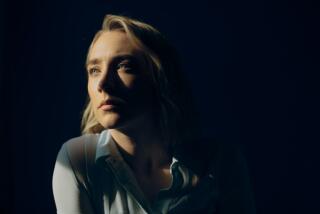Review: Saoirse Ronan and Margot Robbie rule in ‘Mary Queen of Scots,’ but this history lesson is overly pulpy
- Share via
Only one royal has made it into the title, but “Mary Queen of Scots” is in truth a regal double bill, and it’s as a showcase for the two actresses who play dueling monarchs that it is most successful.
The redoubtable Saoirse Ronan, thrice Oscar nominated at age 24, is appropriately regal and commanding as the titular 16th century queen who lost her head.
Margot Robbie, meanwhile, impresses as well in the opposing role of her cousin Elizabeth I, unwilling executioner, sometime geopolitical rival and full-time ruler of England.
The two women never met in real life, but that hasn’t stopped the movies from frequently putting them on film, often together. John Ford’s “Mary of Scotland” featured Katharine Hepburn, of all people, as Mary, while a 1971 British venture had Vanessa Redgrave as Mary, Glenda Jackson as Elizabeth and a shameless advertising slogan: “They used every passion in their incredible duel ... and every man in their savage games of intrigue!”
Though director Josie Rourke and screenwriter Beau Willimon (“House of Cards”) have something loftier and more contemporary in mind with their new “Mary,” the truth is they are not always as far from that description as they might imagine.
Working in close collaboration with historian John Guy, whose authoritative 2004 biography presented the Scottish queen in a more serious, realpolitik light than previous works, this “Mary” does effectively draw parallels between the two as rulers constrained by the restrictive sexual politics of the day.
Though both were monarchs, no small beer, they were queens at a time when women — no matter what their status — had limited agency, and the film is good at detailing how each was hemmed in in different ways by the actions, ambitions and prejudices of men.
Both queens also figured in and had to deal with an exceptional amount of political scheming in relation to each other as well as to the rest of their realm. Left to their own devices they might have been allies, but it was not to be.
Speaking of scheming, “Mary” details so many wheels inside of wheels machinations that even in this inevitably stripped down version of history, it can be hard to follow the plots of Scotland’s Lord Maitland (Ian Hart, excellent as always), England’s devious Sir William Cecil (Guy Pearce) and more.
Perhaps in an inevitable attempt to balance the film’s serious politics and feminist point of view, Rourke has gone in a different direction when it comes to style.
This is the first feature for Rourke, well known in England for her stage work as the artistic director of London’s Donwar Warehouse, and she’s opted for an excessively theatrical, even pulpy, directing approach she has not mastered.
Her work on “Mary” throws in enough lurid depictions of actual and imagined sex and violence to make this play like a celebrity gossip version of history. The idea might have made sense, but the pulpy execution leaves something to be desired.
All these shenanigans, however, are well in the future when Mary returns to Scotland in 1561 after years spent in France, most recently as its queen.
But after the death of her husband, the king, she comes back intent on ruling her homeland’s largely Protestant population as a Catholic queen.
This does not sit well with a number of people, including her half-brother and current ruler the Earl of Moray (James McArdle) and Protestant firebrand John Knox (David Tennant) who thunders “are we to abide a Papist and a woman both?”
Because Mary has a plausible claim to the English throne as well, Elizabeth and her advisers worry about how to handle the delicate situation.
Intending never to marry because a husband would get in the way of ruling, Elizabeth determines to send her paramour Robert Dudley (Joe Alwyn) to Mary in the hopes that the Scottish queen will agree to marry him.
Mary does want to wed, hoping a child will strengthen her position and telling intimates “I will be the woman she is not; I will produce a heir, unlike her.”
But though the film shows us a Mary who is shrewd and capable in terms of political dealings, she has bad instincts about men, falling for a rakish nobleman named Lord Darnley (Jack Lowden), a sketchy individual who proves more trouble than he’s worth in a number of areas.
Though Elizabeth, guided by the relentless Cecil, rarely strays from the all-business path, Mary has a different karma, getting emotionally entangled with a whole range of men, from David Rizzio (Ismael Cruz Cordova), a fey Italian musician who became her secretary, to the bluff Earl of Bothwell (Martin Compston) who begins as her protector and ends as something else entirely.
It may never have happened, but the meeting between Mary and Elizabeth that closes the film is its unchallenged highlight, with both actresses, who had never seen each other in costume and makeup until the moment of filming, brilliantly going one-on-one against each other like basketball phenoms playing for all the marbles.
Bright and charismatic though Mary was, she was, in effect, born under a bad sign, fated, despite all her advantages, not to have anything like the happily ever after that royals have in fairy tales and Disney movies.
In a similar way, despite numerous advantages (including splendid cinematography by John Mathieson), the film with her name on it has promise it does not fully deliver on. But when those queens are on the screen, all bets are off.
--------------
‘Mary Queen of Scots’
Rating: R, for some violence and sexuality
Running time: 2 hours, 3 minutes
Playing: Arclight, Hollywood, Landmark, West Los Angeles
--------------
ALSO
In ‘Mary Queen of Scots,’ a modern feminist spin on the frenemy queens who fought to rule Europe
The queens wore denim: costume designer Alexandra Byrne talks about ‘Mary Queen of Scots’
More to Read
Only good movies
Get the Indie Focus newsletter, Mark Olsen's weekly guide to the world of cinema.
You may occasionally receive promotional content from the Los Angeles Times.











